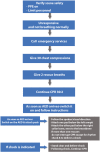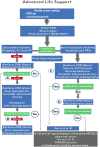Cardiopulmonary resuscitation during the COVID-19 pandemic: a scientific statement on CPR management protocol of Kasr Al-Ainy University Hospital is presented
- PMID: 33108568
- PMCID: PMC7590554
- DOI: 10.1186/s43044-020-00106-9
Cardiopulmonary resuscitation during the COVID-19 pandemic: a scientific statement on CPR management protocol of Kasr Al-Ainy University Hospital is presented
Abstract
Background: The COVID-19 pandemic poses a major burden to the healthcare system in Egypt, and in the face of a highly infective disease which can prove fatal, healthcare systems need to change their management protocols to meet these new challenges.
Main body: This scientific statement, developed by the cardiology department at Cairo University, emphasized 6 different aspects that are intended to guide healthcare providers during cardiopulmonary resuscitation (CPR) in the era of the COVID-19 pandemic. It highlighted the importance of dealing with all cardiac arrest victims, during the pandemic, as potential COVID-19 cases, and the use of appropriate personal protective equipment (PPE) by health care providers during the procedure. It also stated that the CPR procedure should be done in a separate room with the door closed and that the number of providers present during the procedure should be limited to only those who are essential for patient resuscitation. It also stressed that family members and accompanying personnel of patients with possible COVID-19 should not be in the vicinity of CPR site. The statement also pointed out that CPR procedure should be done in the standard manner with precautions to minimize spread of infection to the staff and accompanying people. Early intubation was prioritized, and the use of rapid sequence intubation with appropriate PPE was recommended. For delivery of CPR for the prone ventilated patient, delivery of chest compressions by pressing the patient's back, while a team prepares to turn the patient supine, was recommended. During intra-hospital transport, it was emphasized that the receiving intensive care unit (ICU) should be notified about the possibility of the patient being COVID-19 positive, so that appropriate infection control precautions are taken.
Conclusion: Cardiopulmonary resuscitation of cardiac arrest patients in the COVID-19 era poses a significant challenge, and all health care providers should deal with any cardiac arrest victim presenting to the emergency department as potential COVID-19 suspects and should use the appropriate PPE.
Keywords: COVID-19; Cardiac arrest; Cardiopulmonary resuscitation.
Conflict of interest statement
The authors declare that they have no competing interests.
Figures
Similar articles
-
CardioPulmonary Resuscitation in patients with suspected or confirmed Covid-19. A consensus of the Working group on CardioPulmonary Resuscitation of the Hellenic Society of Cardiology.Hellenic J Cardiol. 2021 Jan-Feb;62(1):24-28. doi: 10.1016/j.hjc.2020.09.010. Epub 2020 Sep 17. Hellenic J Cardiol. 2021. PMID: 32949726 Free PMC article. Review.
-
Prone Cardiopulmonary Resuscitation (CPR) Protocol: A Single-Center Experience at Implementation and Review of Literature.Cureus. 2022 Sep 26;14(9):e29604. doi: 10.7759/cureus.29604. eCollection 2022 Sep. Cureus. 2022. PMID: 36321034 Free PMC article. Review.
-
Preparedness of personal protective equipment and implementation of new CPR strategies for patients with out-of-hospital cardiac arrest in the COVID-19 era.Resusc Plus. 2020 Sep;3:100015. doi: 10.1016/j.resplu.2020.100015. Epub 2020 Jun 25. Resusc Plus. 2020. PMID: 34031648 Free PMC article.
-
2005 American Heart Association (AHA) guidelines for cardiopulmonary resuscitation (CPR) and emergency cardiovascular care (ECC) of pediatric and neonatal patients: pediatric basic life support.Pediatrics. 2006 May;117(5):e989-1004. doi: 10.1542/peds.2006-0219. Pediatrics. 2006. PMID: 16651298
-
Cardiopulmonary Resuscitation during COVID-19 Pandemic: Outcomes, Risks, and Protective Strategies for the Healthcare Workers and Ethical Considerations.Indian J Crit Care Med. 2020 Sep;24(9):868-872. doi: 10.5005/jp-journals-10071-23544. Indian J Crit Care Med. 2020. PMID: 33132575 Free PMC article. Review.
Cited by
-
Prolonged Resuscitation with Multiple Defibrillations; a Case Report.Arch Acad Emerg Med. 2022 May 26;10(1):e40. doi: 10.22037/aaem.v10i1.1583. eCollection 2022. Arch Acad Emerg Med. 2022. PMID: 35765614 Free PMC article.
-
Health care workers' perceptions of their hospitals' preparedness during the COVID-19 virus pandemic in three different world regions.Clin Epidemiol Glob Health. 2023 May-Jun;21:101278. doi: 10.1016/j.cegh.2023.101278. Epub 2023 Apr 2. Clin Epidemiol Glob Health. 2023. PMID: 37033720 Free PMC article.
-
Exposure-response relationship between COVID-19 incidence rate and incidence and survival of out-of-hospital cardiac arrest (OHCA).Resusc Plus. 2023 Jun;14:100372. doi: 10.1016/j.resplu.2023.100372. Epub 2023 Feb 28. Resusc Plus. 2023. PMID: 36891134 Free PMC article.
References
-
- Taha HS, Bakhoum SWG, Kasem HH, Fahim MAS. Cardiopulmonary resuscitation quality of cardiopulmonary resuscitation of in-hospital cardiac arrest and its relation to clinical outcome: an Egyptian university hospital experience. Egyptian Heart J. 2015;67:137–143. doi: 10.1016/j.ehj.2014.11.001. - DOI
Publication types
LinkOut - more resources
Full Text Sources


